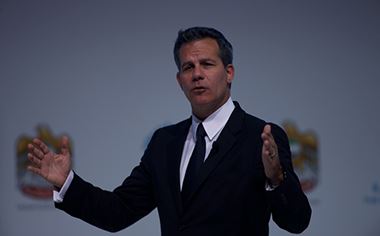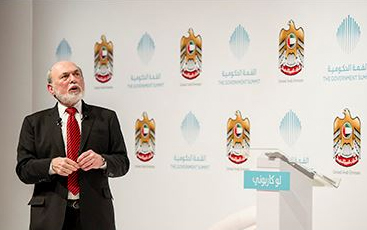The world in 2050
Dr Peter Diamandis, Co-Founder of Singularity University and Founder of the X-Prize (US), spoke in the plenary session on the second day of The Government Summit about how the world would be like in 2050, and the technologies and phenomena that would make it so. He shared insights on how bright the future looks and what are the trends that will shape the world as we know it in the next 25 years.
Focusing on “breakthroughs leading to a world of abundance,” Dr. Diamandis spoke of a world where the needs of every man, woman and child are met and spoke of a shift in thinking, from 150,000 years of linear and local human development that progressed in centuries and decades, to an exponential and global curve that is pushing progress in years and months.
Globally renowned as the founder of the X-prize challenge as well as other initiatives that impact citizens globally and know no boundaries, Dr. Diamandis based his picture of the future on trends that have shaped the previous 25 years, opening the audience up to some very striking possibilities.
“In 10 years from now, 40% of the current Fortune-500 companies will not exist,” said Dr. Peter Diamandis.
“We’ve seen a 150,000-times improvement in computing power in 25 years,” he noted. “In next 25 years, computers will be everywhere,” he said.
Talking about Linear vs. Exponential growth, he says, the difference is either “disruptive stress or opportunity,” depending on the point of view. Using an example of a kid who has created a brand new technology in his garage juxtaposed the giant conglomerate this technology is going to drive out of business, Diamandis explains the different points of view of this disruption in human development. He cited Kodak’s fall from imaging giant in 1999, with a $28B market cap and 140,000 employees, to bankruptcy in 2012, put out of business by the same technology developed within their offices, by engineer Steven Sasson. Sasson developed a “.01 megapixel camera the size of an oven toaster and showed it to Kodak,” Diamandis noted, who turned it down because of its infantile capabilities, choosing instead to focus on their high-resolution film photography.
Diamandis also noted that exponential progress “does not stop here, [it will] continue exponentially.” He highlighted that human progress in general and in technology specifically, is independent of what is going on in the world like wars, famine or drought.
“Faster, cheaper computers are driving progress,” the Singularity co-founder said, showing how, in 2023, computers will have the processing power of the human brain, and in 2050, the processing power of the entire human race.
He noted that with this unseen power in the hands of more and more people, taking an idea to commercial application has become faster, prediction that in 10 years, 40% of Fortune 500 companies will no longer exist, put out of business by companies we do not even know yet.
He offered three key insights in to current and future human development: the only constant is change, that the rate of change is increasing and that tech convergence leads to unexpected results.
Discussing states of the technology, he expanded on how Artificial Technology (AI) is changing the world right now, doing most tasks better than humans and poised to take 50% of service jobs in the next decade, all while empowering the individual. He touched on the progress being made on autonomously driven vehicles, the advances in, and practical applications of, robotics, 3D printing, genome sequencing, and commercial space travel pioneered by his X-Prize project.
In Diamandis’ 2050, we will have perfect knowledge – we will be able to see and know anything, any time, saying that “technology has made what was scarce, abundant.”






































